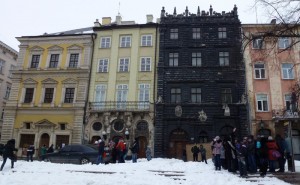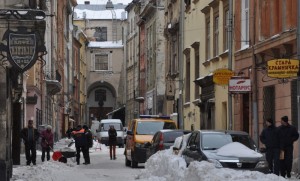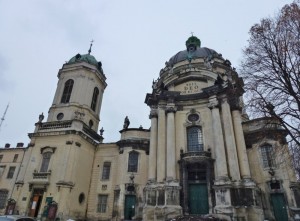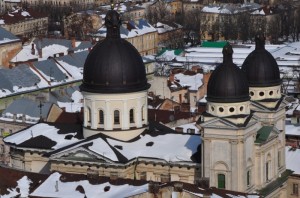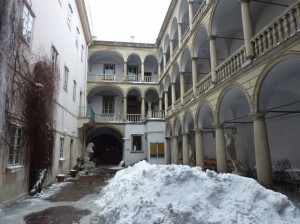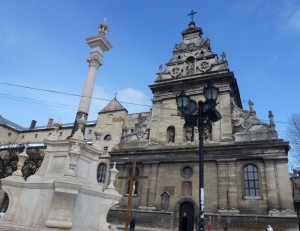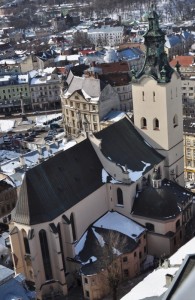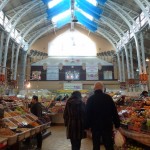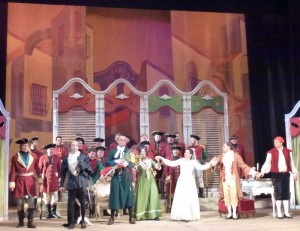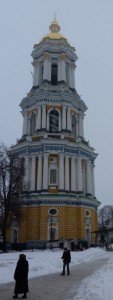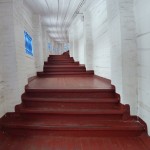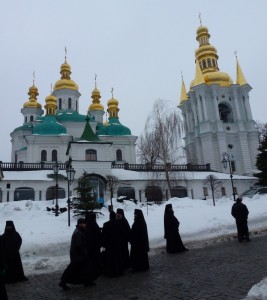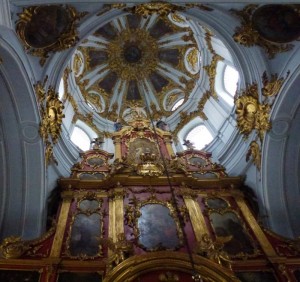Lviv & Kiev March 26-31
March 26 Tuesday: Lviv
Lviv with a population of about 800,000 has been described as Ukraine’s most elegant city and an outstanding example of the fusion of the architectural and artistic traditions of Eastern Europe with those of Italy and Germany. Settlement in the area began in the mid-5th century AD at the crossing point of important trade routes linking the Baltic, central Europe, the Mediterranean and Asia. By the 13th century, Lviv had developed into an organized and a well-fortified town. The old city is packed with beautiful and eclectic monuments to art, history and all the fortitude of European culture.
 The city was founded by Prince Danylo of Halychyna of Galicia in 1256 in honour of his son, Leo, hence the name Lviv from the Slavic root for ‘lion’. Naturally, lion is the city’s symbol. Lviv became the capital of the joint kingdom of Halychyna and Volyn in 1272 but was annexed to Poland in 1340. It was made the seat of a Roman Catholic archbishopric in 1412. The Polish rule attributed to the cobblestones, Baroque architecture, the Catholic faith and Polish language.
The city was founded by Prince Danylo of Halychyna of Galicia in 1256 in honour of his son, Leo, hence the name Lviv from the Slavic root for ‘lion’. Naturally, lion is the city’s symbol. Lviv became the capital of the joint kingdom of Halychyna and Volyn in 1272 but was annexed to Poland in 1340. It was made the seat of a Roman Catholic archbishopric in 1412. The Polish rule attributed to the cobblestones, Baroque architecture, the Catholic faith and Polish language.
The political and commercial role of Lviv attracted a number of ethnic groups with different cultural and religious traditions to establish their communities. It gradually grew into a metropolis of wealthy foreign merchants and churchmen. The Ukrainian, Armenian and Jewish communities were self-governing. Rivalry amongst these communities resulted in the creation of many architectural and artistic masterpieces. During the 16th and 17th centuries, it also developed into an intellectual and artistic city. About half of Ukraine’s recognized architectural monuments are now found in the well-preserved old city which is a World Heritage Site.
Lviv was badly hit by the Ottoman siege in 1672 and was sacked by Charles XII of Sweden in 1704. Following the partition of Poland in 1772, it became the capital of the new Austrian province and many medieval buildings were reconstructed. In 1918, it became part of the new Republic of Poland and was returned to Ukraine after the Second World War.
I had a lovely leisure day exploring the old city on foot. The Rynok Square (Market Square) surrounded by beautiful fine houses in Renaissance, Baroque and Empire style is at the heart of the city. Half a dozen churches with imposing domes and bell towers dominate the skyline.
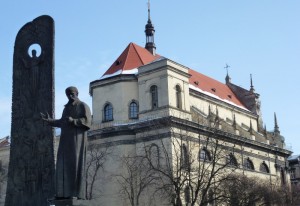 |
Lviv is an open air museum filled with monuments, squares and churches. I began my walk at the Shevchenko Monument. Shevchenko (1814-61) was a poet, a philosopher, a painter and a figure representing the liberation of the nation. His statute has replaced Lenin’s statute after the Soviet era. At the end of the square is the Opera and Ballet Theatre built in grand Viennese style.
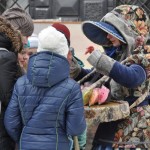 |
 |
 |
I headed back to the Market Square, the heart of the city where the City Hall stands in the middle with four fountains (one in each corner) dating from 1793 with figures from classical mythology. Then I visited three churches namely the Transfiguration Church, the Armenian Cathedral complex which is the oldest in the city with the church built in 1363 and the bell tower in 1571 and the Dominican Cathedral dating to the second half of the 13th century with a bell tower built in 1865.
 |
 |
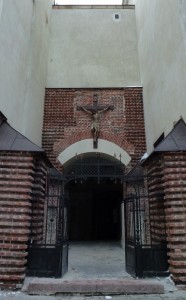 |
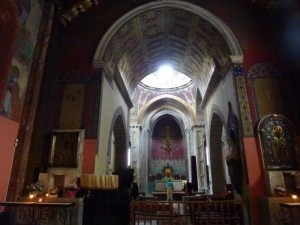 |
 |
There are dozens of museums and I picked three of them. The Museum of the Religion History housed in the former Dominican Monastery contains lots of artifacts for Orthodox Christianity and some items from other religions. The Black Stone House which construction began in 1588 is now Lviv’s historical museum. All the exhibits are in Ukrainian and I could have skipped it. The King Jan III Sobiesk Palace Museum, the largest structure on the square, built by a Greek merchant named Constantine Kornjakt in late 16th century is worth visiting. It has several beautiful halls including the Gothic Hall and the Royal Chambers and many exquisite exhibits. The next owner of the house was Jakub Sobieski, father of the future Polish king Jan III. The Polish-Russian Eternal Peace Treaty was signed here in 1686. The garden built in Italian style is called ‘Italian Yard’ with a lively café.
I had brunch in a newly opened café decorated with water pipes. Lviv is not cheap by Ukrainian standards: I paid 62Hr for a coffee and two pieces of strudels. I saw a full day bus tour to see three castles on the “Golden Horse-Shoe” route for 180Hr and booked this side trip.
 |
In the afternoon, I went to the Gunpowder Tower the oldest and best preserved remaining tower of the medieval city wall dating from 14th century. I went to the Church of the Discalced Carmelite Nuns on the hillside but it was closed. I then walked back to vul Ruska (the thoroughfare since the Middles Ages) to see the Uspenska complex (Assumption Church) which combines Renaissance building in stone with the local tradition of tripartite wooden places of worship. I had a rich and thick hot chocolate for 22Hr at the famous Lviv Handmade Chocolate which occupies a beautiful restored townhouse with five levels on vul Fedorova. I walked past the former Jewish quarter to reach the Bernardine Cathedral and Monastery, an impressive fortified complex which combines Italian and German Renaissance elements with Mannerist details.
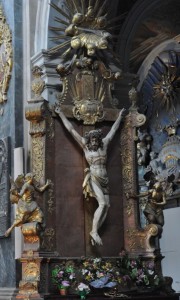 |
 |
I had a nice time at the Lviv National Art Museum which has a fabulous collection of icons with excellent explanations. I finished my day at the Baroque St Peter and St Paul Church of the Jesuit Order which construction began in early 17th century. The church which is under renovation is grand and atmospheric with dim lights and darkened walls.
I went to the train ticket office in the centre to purchase tickets to Kiev and Moscow. The staff did not speak English and I was lucky in standing behind Roman, a young Ukrainian girl who speaks English. She spent almost half an hour in helping me get a ticket in a four-bedded compartment from Kiev to Moscow on an overnight train on April 31 for 680Hr. While tickets on a 5-hour fast train Kiev (280Hr) departing Lviv at 7am on April 29 were available, I could not get a ticket on any of the four overnight trains to Kiev on April 28. I was told to return the following day after 3pm. (I cannot understand the ticketing system)
March 27 Wednesday: The Golden Horse Route (200km)
I started the day with a nice coffee at Coffee Manufacture at the Market Square. At 9:45am, I boarded the tourist bus together with 25 local tourists. The first stop was Olesko Castle, 75km east of Lviv. The bus was held up in traffic and we did not get there till 11:45am. The tourist guide spoke during the entire journey! I did not understand the language and was irritated by the loud speaker. I believe a good guide should provide adequate background information. But talking non-stop for two hours is excessive.
 |
 |
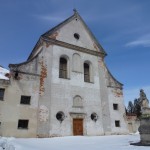 |
When we arrived at the Castle, I asked the guide when I should be back to the bus. She said 40 minutes later. I wandered around on my own with the aid of an English pamphlet. The castle, an outstanding architectural and historical landmark of the 13th – 18th centuries, is standing on a hill with commanding views of the expansive plain. It was rebuilt in the Renaissance style in the 1620s. King Jan III Sobieski was born here. I spent half an hour in the castle looking at hundreds of paintings, sculptures and applied art of 10th – 19th centuries. I find the icon ‘Last Judgment’ (late 16th century) most interesting. I returned to the bus before 12:30pm. To my dismay, the guide and the group did not turn up till 1pm. I complained to the guide and said she should have told me to be back at 1pm.
The next stop was the Pidhirtsi Castle built in 1637-41. It is a remarkable monument to late Renaissance architecture with a palace surrounded by bastion fortifications, ramparts and entrenchments. The Palace is under restoration and there is not much to see inside. The Baroque Latin church (1752-66) nearby is also closed. I took a quick walk around the ramparts before boarding the bus at 2pm.
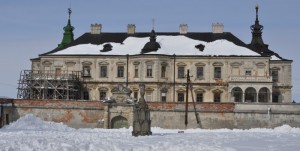 |
 |
 |
Our final stop was the Zolochiv Castle which was built as a citadel with bastions by Jacub Sobieski. There are two museums inside the citadel. The guide took us to buy a ticket for the Renaissance Great Palace and I walked on our own. When I arrived at the Chinese Palace, the attendant told me to get another ticket. I did not bother to go inside. Instead, I climbed the walls and had a quick lunch (35Hr) with a group of eight high school students from a private school with their teacher from Odessa. They would be returning to Odessa by train the following day.
 |
 |
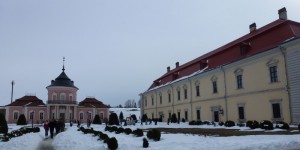 |
 |
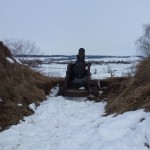 |
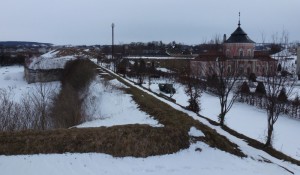 |
The tour finished at 3pm and I arrived in Lviv shortly after 5pm. I went to the train ticket office to get my ticket to Kiev. Unfortunately, the centre was closed as a result of a power cut and I had to go all the way to the train station. What a nuisance!
I was lucky to meet Annie, a young university student who was in Shanghai last summer. She was also trying to get a return ticket to Kolomiya to see her family. We took the tram and I managed to get a ticket for 138Hr in a four-bedded compartment on the train leaving Lviv at 11:20pm.
March 28 Thursday: Lviv – Kiev (540km)
As the weather had improved and was warmer, I felt energetic and had a full day in Lviv.
Tower of the City Hall – I climbed 418steps to reach the top and was rewarded with great view of city.
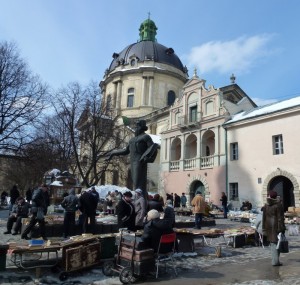 |
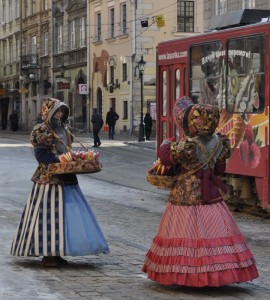 |
Latin Cathedral (1360) – It was built in a Gothic style with some Baroque features. Closely by is the Chapel of the Boim Family built in 17th century with elaborate sculptures on the exterior.
Lychakiv Cemetery – Many national figures including Ivano Franko (1856-1919), are buried here. It reminds me the beautiful cemetery in Milan.
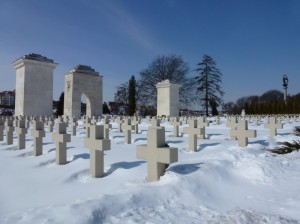 |
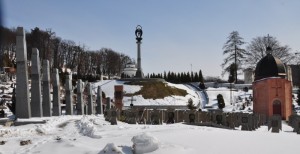 |
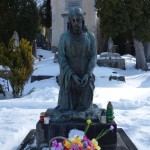 |
 |
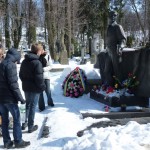 |
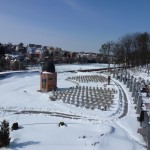 |
Pinzel Museum– This museum shows the works of the 18th century Lvivian sculpture Johann Pinzel. But it was closed.
I had a set lunch at the Wien Café for 60Hr. It’s value-for-money as compared with my coffee and strudel brunch.
Museum of Ethnography and Art Crafts– It is housed in an old 1920s Soviet bank. The building is dilapidated but the ceiling, murals and staircases are beautiful. Given Lviv’s rich history, I found the exhibits disappointing.
Lviv Art Gallery– While the directional signs are generally good, the ones for this gallery are confusing. As a result, I got lost and did not reach the Gallery till almost 5pm. The lady in charge kindly let me in free for 10 minutes. The collection is good and several pieces of Johann Pinzel’s sculptures are temporarily exhibited here.
On my way back to the city centre, I discovered another museum at the Potocki Palace. A local man approached me and took me to see an exhibition by Falun Gong next to the Palace. This organization has been promoting itself under the disguise of art and cultural events.
I had a long day and decided to reward myself with a good dinner. I went to the House of Legends and ordered a hot-pot with potatoes and pork. But the dish prepared by Lyuba in Chernivtsi was much better. I stayed in the hostel till 10:30 pm and then went to the railway station by taxi. The fare was only 20Hr. I had a good sleep on my way to Kiev.
March 29 Friday: Kiev
Kiev has a glorious as well as turbulent past. Its fame and wealth has led to invasion and annexation by the Mongol, Tatar, Pole, Lithuanian and Russian. The intellectual tradition and large labour population have made it an important city in the dissent and popular revolt against the Russian. During the October Revolution and subsequent civil war, Kiev changed hands 18 times till the final Bolshevik victory in 1921. The capital of the Ukrainian SSR was moved from Kiev to Kharkiv but was moved back to Kiev in 1934. During the Second World War, 180,000 civilians were executed at Babi Yar and many lost their lives. In 1986, the nuclear plant at Chernobyl north of Kiev exploded and inhabitants were kept in the dark for over a week. Pattern of chronic illness are only being recognized now.
 |
I spent three full days in Kiev and had a good time despite the poor weather. I arrived at the expansive Kiev train station from Lviv at 7:30am. After storing my suitcase in the train station for 15Hr a day, I took the metro to the city centre and easily found TIU Khreschatik, a centrally located and well-run hostel recommended by Marcus in Chernivtsi. Roman, a nice young man runs this small but clean and cozy hostel. I happily stayed there for two nights.
 Kiev had a heavy snowfall on the day when I was at Kamyanets. The city government was still busy in clearing the snow. On the first day, I had fine weather with a blue sky and walked for several hours.
Kiev had a heavy snowfall on the day when I was at Kamyanets. The city government was still busy in clearing the snow. On the first day, I had fine weather with a blue sky and walked for several hours.
First stop: St Mikhayil’s Monastery of the Golden Domes with a pyramid of bright domes. Several different monasteries stood on this spot from the 12th century. But the historical and beautiful church was destroyed during the Stalin’s destruction wave in 1937. The present structure owned by the Ukrainian Orthodox Church (Kiev Patriarchate) was completed in 2001. I visited the museum which details the crime and destruction of the old church and climbed the bell tower for a view of both this monastery and the nearby St Sophia’s Cathedral.
 |
 |
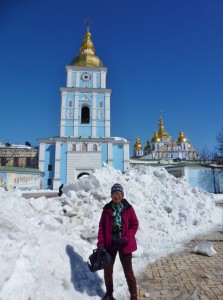 |
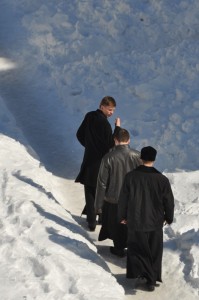 |
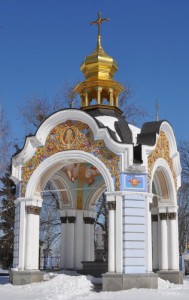 |
 |
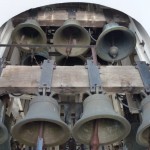 |
 |
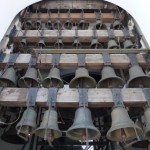 |
Second stop: St Sophia’s Cathedral (a World Heritage Site), Kiev’s most visible landmark. The original structure, a Greek-cross church was built in 1037 when Grand Prince Yaroslav the Wise ordered the church to be built to thank God for defending Kiev against the Mongol invasion in 1024. The church was brought into the monastery in the 17th century and a bell tower was added in 1752 and later became the ecclesiastical centre for the Orthodox metropolitans (similar to archbishops). The vast complex including was turned into a cultural reserve and not a consecrated house of worship at the command of Stalin.
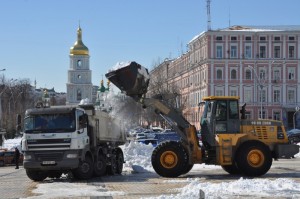 |
 |
The Cathedral complex is now a museum. The 13-domed cathedral is one of the major edifices representing the culture of Eastern Christianity in the 11th century inspired by Byzantine models. It represents a perfect fusion between symbolic image and architecture: big central gilt cupola and 12 smaller cupolas which crown it evoke Christ and the 12 Apostles in a pyramidal composition. There are well-preserved Byzantine mosaic, hundreds of 1000-year old frescoes and the sarcophagus of Yaroslav the Wise. I also saw the Metropolitan’s House and a small museum in the complex.
 |
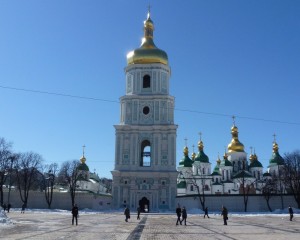 |
 |
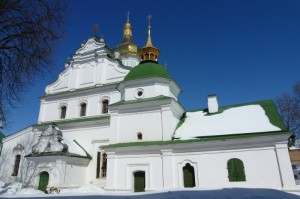 |
 |
 |
 |
Walk-I strolled from the Sofiyska Square to Kontraktova Ploscha via the famous and interesting Andriyivsky Uzviz where the famous St Andrei’s Church with striking sea-green domes is located. According to legend, Andrew, the first apostle to be called to follow Christ, sailed up the banks of the Dnepr and landed where the church now stands.
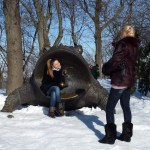 |
As the weather was very good, I decided to walk to the Khreschatyk Park which can go all the way to the Kievo-Pecherska Lavra (a World Heritage Site where the Caves Monastery is located). But I found it not easy to walk in the snow and decided to turn back when I reached the Marinsky Park. Before returning to the hostel, I visited the traditional Bessarabsky market which sells fairly pricy seafood and caviar, meat, fresh vegetables and fruits. I brought vegetables and drumsticks and prepared dinner in the hostel.
 |
March 30 Saturday: Kiev
Weekend is time for rest. I did not get up till 9am. As the weather was poor, I was not in a ‘tourist’ mood and only pulled myself together to get out at noon. It was not too cold (i.e. just below zero) but the slush was unpleasant. My boots were wet and I had hardly taken any photo.
I spent the whole afternoon in two museums located on Tereschenkivska Street next to the Shevchenka Park. The National Museum of Russian Art is said to have an outstanding collection including many world-known masterpieces of D. Levitsky, V. Borovikovsky, I.Kramskoy, I Shishkin etc. But without any explanation in English, I cannot find nor appreciate these masterpieces and their significance.
My visit to the Bohdan and Varvara Khanenko National Museum of Art was most rewarding. Founded in 1919 on the basis of private art collection of Bohdan Khanenko and his wife Varvara, it is the largest museum of world art in Ukraine. Their splendid and elegant house provides an exquisite setting for their outstanding collection of painting, sculptures, prints, drawings and decorative art of Europe and Asia, and art pieces from Ancient World. I spent over two hours reading the well-written detailed descriptions and am particularly interested in the four Byzantine encaustic icons from the Sinai Monastery dating back to 6th -7th centuries, the Japanese colour woodblock prints and a Tibetan painting of Ching Emperor Qianlong surrounded by Tibetan monks in the 18th century.
On my way back to the hostel, I passed by the University painted in red, the National Opera House (1901), the ‘Golden Gate’, a pre-Mongol fortress and the Maidan Nezalezhnosti (Independence Square). The Monument of Independence, a white and gold pillar, was erected in 2001.
In the evening, I went to the National Musical Academy to see an opera, Barber of Servile by Rossini. Though it was a performance by the students of the Academy and their professors, the performers are professionals. The orchestra was good and I had a most enjoyable cultural evening for 35Hr! The show was over by 9:30pm.
When I got back to the hostel, it was dark. I thought everyone was out as it was Saturday night. I was wrong – most of the people were already in bed!
March 31 Sunday: Kiev – Moscow (about 860km)
No one should visit Kiev without seeing the Kievo-Pecherska Lavra (Caves Monastery), a monastery complex consisting of numerous monuments and grottoes. The ancient monastic foundation plays a very important role in the spiritual and intellectual life of the Russian world and Lavra, the holiest place in Ukraine is of outstanding significance in the Ukrainian national heritage.
I looked at several monuments on my way to Lavra. The Famine Monument which commemorates some 6 million people who died in the famine in 1932-33 is new with modern sculptures.
The sight of the enormous and impressive ensemble of white church halls of Lavra with green and gold rooftops is unforgettable. The history of Lavra dates back to Prince Vladimir’s introduction of Christianity as the new religion of Rus. Then St Anthony of Lyubech left Mount Athos in Greece and settled in a manmade cave on the banks of the Dnepr in 1051. Later, more caves were made to accommodate more disciples leading to the formation of an extensive underground network where monks spent entire lifetimes meditating, praying and writing. Churches and monasteries were built on the surface later. Devastated by the Mongols and the Tatars, Lavra was almost entirely rebuilt in the 17th century and afterward. A print shop was founded in 1615, mainly issuing devotional literature and history.
Today the major elements of the very old historic heritage are Trinity Church, whose 12th-century structure is hidden by the extremely rich Baroque decor, and especially the catacombs, which include the Near Caves and the Far Caves, whose entrances are respectively at All Saints’ Church and at the Church of the Conception of St Anna. Over the years the monks’ cells became a necropolis where hundreds of their mummified bodies have been preserved.
 |
 |
The entrance fee for visitors is 50Hr providing access to eight museums. I visited the Church of the Assumption (Dormition Cathedral) (1077) which is the oldest church above ground. I stayed for a long time in the Refectory and Chapel of Saints Anthony and Theodosius which was packed with pious worshippers.
 |
 |
I found my way to Khrestovozdyvzhenska Church where the entrance to the Near Caves is located. I followed the locals and entered the caves through a very narrow tunnel. It was dark and I did not see the way ahead. Suddenly a male voice told me to get a candle. As I could not turn back to buy one, he gave me one! It’s really a mystical experience: I watched people kissing the graves and icons and praying on their knees. There are different routes and the guard did not allow me to enter a tunnel which is reserved for pilgrims.
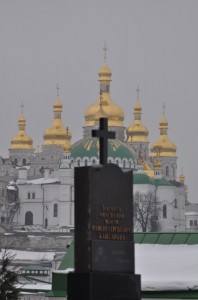 |
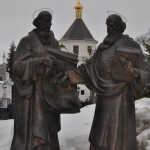 |
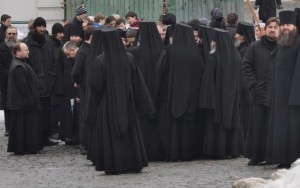 |
Unfortunately, I did not read the guide book thoroughly about where to find the Far Caves. I passed the Church of the Annunciation without entering and missed the entrance. I was at the Church of the Birth of the Blessed Virgin (1696) without realising the exit of the caves is there. I understand the tunnels are fairly deep underground and barely measures 6ft high and 2ft wide. Perhaps, Sunday full of visitors is not a good day for such a visit. If I am back in Kiev one day, I shall visit the Far Caves. I did not bother to walk all the way to see the Statute of Mother of Ukraine and took a snapshot from the cemetery of the Church of the Birth of the Blessed Virgin.
Of the eight museums I visited with my ticket, I enjoyed two of them. The exhibition on “Ukraine the World” has many beautiful exhibits dating 4000 BC. I have not realized the long history and rich history of this region. The display on the Napoleonic War 1812 with some English explanations is good.
I took a bus back to the Khreschatyi Square and had a simple lunch with bosch and 12 dumplings for 24Hr. The food is delicious and not salty at all!
The rain had stopped. I walked to the Prince Vladimir Monument which overlooks the Dnepr. Then I took a tram to the lower part of the city before walking back to the upper part through the Andriyivsky Uzviz. The sky was grey and the area was not as picturesque as before. I went into the St Andrei’s Church which interior is elaborately decorated in the Baroque style.
 |
I spent the last evening in the hostel sorting out my travel notes. I arrived at the train station before 11pm. The train though late in arriving at the station departed on schedule at midnight. I woke up around 2pm by the immigration and customs officials. Soon, the train was back on its way to Moscow and I went back to sleep!



